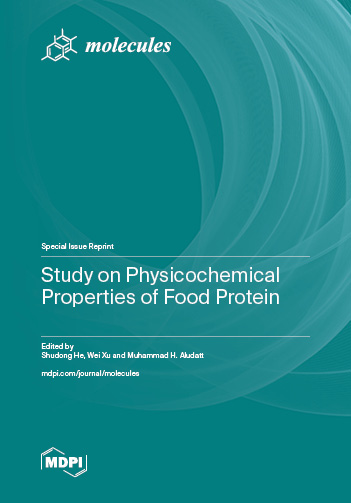Study on Physicochemical Properties of Food Protein
A special issue of Molecules (ISSN 1420-3049). This special issue belongs to the section "Food Chemistry".
Deadline for manuscript submissions: closed (31 July 2023) | Viewed by 16205
Special Issue Editors
Interests: food protein; food peptide; food allergy; food characteristics; food flavor; beverage development; edible film
Special Issues, Collections and Topics in MDPI journals
Interests: food protein; food peptide; food characteristics; food flavor
Special Issues, Collections and Topics in MDPI journals
Interests: food chemistry and technology and their application in human nutrition (in vitro study including allergic, diabetics, hypertension and cancer)
Special Issue Information
Dear Colleagues,
With the increasing demands for nutrition and health, especially in the COVID-19 pandemic, more and more consumers are paying attention to the nutritional values of food proteins and protein-derived peptides from crops and animals. Food proteins supply adequate amounts of essential amino acids, but also contribute to the general well-being maintenance and the intervention against human diseases. Therefore, the exploitation and application of food proteins have been the primary focus of the food industry. Due to the difference in the physicochemical properties of various food proteins, such as the solubility, swelling, water retention capacity, foaming properties, gelling capacity, emulsifying and fat binding properties, it is necessary to scientifically study the quality and sensory attributes of protein foods in terms of preparation, processing, storage, and consumption. Furthermore, the physicochemical properties of proteins can be optimized by many innovative thermal and non-thermal methods including ultrasound, pH-shifting, high pressure, irradiation, glycosylation, pulsed electric field, and enzymatic modification, to improve the applicability of proteins in the food industry. Thus, more effort needs to be paid to understanding the relationship between the structure and functional properties after protein modification. Besides, the interactions of protein molecules with other food ingredients and their effects on macroscopic properties of the food systems should be considered. The Special Issue aims to publish the most advanced investigations on the physicochemical properties of food proteins and provide useful information about the structure-function relationship based on the protein modifications to explore the potential of the food proteins in food development.
Dr. Shudong He
Dr. Wei Xu
Dr. Muhammad H. Aludatt
Guest Editors
Manuscript Submission Information
Manuscripts should be submitted online at www.mdpi.com by registering and logging in to this website. Once you are registered, click here to go to the submission form. Manuscripts can be submitted until the deadline. All submissions that pass pre-check are peer-reviewed. Accepted papers will be published continuously in the journal (as soon as accepted) and will be listed together on the special issue website. Research articles, review articles as well as short communications are invited. For planned papers, a title and short abstract (about 100 words) can be sent to the Editorial Office for announcement on this website.
Submitted manuscripts should not have been published previously, nor be under consideration for publication elsewhere (except conference proceedings papers). All manuscripts are thoroughly refereed through a single-blind peer-review process. A guide for authors and other relevant information for submission of manuscripts is available on the Instructions for Authors page. Molecules is an international peer-reviewed open access semimonthly journal published by MDPI.
Please visit the Instructions for Authors page before submitting a manuscript. The Article Processing Charge (APC) for publication in this open access journal is 2700 CHF (Swiss Francs). Submitted papers should be well formatted and use good English. Authors may use MDPI's English editing service prior to publication or during author revisions.
Keywords
- food protein
- physicochemical properties
- structure-function relationship
- modification
- bioactivity
- food processing









